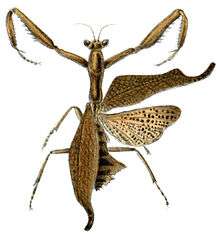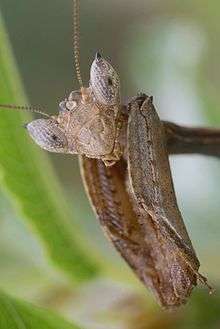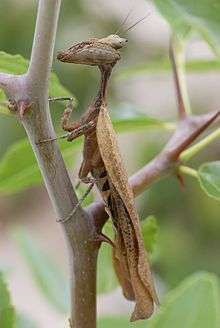Acanthops
| Acanthops | |
|---|---|
 | |
| Adult female Acanthops falcataria | |
| Scientific classification | |
| Kingdom: | Animalia |
| Phylum: | Arthropoda |
| Class: | Insecta |
| Order: | Mantodea |
| Family: | Acanthopidae |
| Subfamily: | Acanthopinae |
| Tribe: | Acanthopini |
| Genus: | Acanthops Serville, 1831 |
| Species | |
|
20 species (see text) | |
| Synonyms | |
|
Plesiacanthops Chopard, 1913 | |
Acanthops is a genus in the subfamily Acanthopinae of the family Acanthopidae, containing 20 species that can be found in Central and South America.
Description
Most species in Acanthops are colloquially referred to as the Dead Leaf Mantis, a common name also used for species in several other mantid genera. The genus name translates from the greek nouns ἄκανθα and ὅψ as "thorn eye", referring to the presence in all Acanthops species of a shorter or longer conical tubercle on top of each eye. Note that such ocular tubercles also occur in various other mantid genera.
Acanthops species have an unusual degree of sexual dimorphism compared to other mantids. The flightless female resembles a curled dead leaf folded back on itself, and weighs twice as much as the males do. It has reduced wings that can be raised to reveal bright warning colors on the abdomen. The male has long functional wings that resemble a flat or rolled-up dead leaf at rest. When perched, males often assume a posture where the head, grasping legs and prothorax add to the camouflage effect by recreating the appearance of a dead leaf's shriveled petiole and stipules.
Taxonomy
The following species are currently considered valid:[1][2][3][4]


_(28246585095).jpg)
- Acanthops bidens Hebard, 1922
- Acanthops brunneri Saussure, 1871
- Acanthops centralis Lombardo & Ippolito, 2004
- Acanthops coloradensis González, Miller & J Salazar, 2011
- Acanthops chocoensis Salazar in Ariza & Salazar-E, 2005
- Acanthops contorta Gerstaecker, 1889
- Acanthops elegans Lombardo & Ippolito, 2004
- Acanthops erosa Serville, 1839
- Acanthops erosula Stal, 1877
- Acanthops falcataria (Goeze, 1778)
- Acanthops falcata Stal, 1877
- Acanthops fuscifolia (Olivier, 1792)
- Acanthops godmani Saussure & Zehntner, 1894
- Acanthops occidentalis Lombardo & Ippolito, 2004
- Acanthops onorei Lombardo & Ippolito, 2004
- Acanthops parafalcata Lombardo & Ippolito, 2004
- Acanthops parva Beier, 1941
- Acanthops royi Lombardo & Ippolito, 2004
- Acanthops soukana Roy, 2002
- Acanthops tuberculata Saussure, 1870
See also
References
- ↑ Francesco Lombardo & Salvatrice Ippolito (2004). "Revision of the species of Acanthops Serville 1831 (Mantodea, Mantidae, Acanthopinae) with comments on their phylogeny". Annals of the Entomological Society of America. 97 (6): 1076–1102. doi:10.1603/0013-8746(2004)097[1076:ROTSOA]2.0.CO;2.
- ↑ https://www.researchgate.net/profile/Ariza_Gloria_Maria/publication/258221833_Nuevas_especies_de_mntidos_para_Colombia_(Insecta_Mantodea)/links/00b49527662722dd05000000.pdf Ariza G.M. & Salazar J.A. 2005. Nuevas especies de mántidos para Colombia (Insecta: Mantodea). Boletín Científico Centro de Museos 9: 121-135.
- ↑ http://www.scielo.org.co/scielo.php?pid=S0123-30682011000100016&script=sci_arttext&tlng=pt González R., Miller & Salazar, J. 2011. Description of a new species of Acanthops Audinet-Serville 1831 from Colombia (Dictyoptera: Mantodea). Boletin Cientifico Museo de Historia Natural Universidad de Caldas 15: 206-212.
- ↑ http://www.gbif.org/species/1404248 Acanthops entry in GBIF